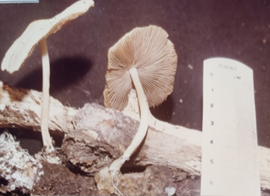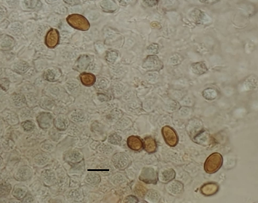Pluteus cervinus var. eximius (W. Saunders & W.G. Sm.) Sacc., Sylloge Fungorum 20: 464 (1911) Fig.5
MycoBank number: MB 137876; Index Fungorum number: IF 137876; Facesoffungi number: FoF 10770;
Basionym: Agaricus cervinus var. eximius W. Saunders & W.G. Sm., Suom. Elain-ja Kasvit. Seuran Van. Tiedon. Pöytäkirjat: tab. 38 (1870)
Synomyms: Pluteus eximius (W. Saunders & W.G. Sm.) Sacc., Sylloge Fungorum 5: 666 (1887) Pluteus cervinus subsp. eximius (W. Saunders & W.G. Sm.) Sacc., Sylloge Fungorum 5: 666 (1887)
Pileus 4.0 – 12.0 cm in diameter, sepia, hazel or umber-brown with slightly darker radial streaks, convex to campanulate with umbo, later becoming plane with an expanding umbo, uplifted at maturity, smooth, surface dry, viscid in wet conditions, cap fragile, with striate margin , flesh thin and smooth. Stipe length 7.0 – 12.0 cm × 1.0 – 1.5 cm in diameter, white, central, cylindrical, fibrillose, equal or slightly swollen at the base with basal mycelial strands, annulus and volva absent. Lamellae white becoming dull pink to light brown, lamellulae three tiered, free, thin, crowded, edge wavy and white. Spores 7.0 – 8.0 × 5.0 – 6.0µm, ovoid to broadly ellipsoid, angular, with an apical germ pore, golden- brown with a smooth wall Basidia 4-spored, clavate in shape. Lamellae edge heteromorphous with numerous cheilocystidia which are thin–walled , apically encrusted. Pleurocystidia absent.
Ecology and distribution – Pluteus cervinus subsp. eximius is found North America, Central Europe, Asia, Africa, South America (Guzmán 1970, Sulzbacher et al. 2013) and Brazil (Gurgel et al. 2008, Montagner et al. 2015), Mexico (Guzmán et al. 2013) and Argentina (Nouhra et al. 2012). Presently, it has been reported from Mount Abu, Sirohi district of Rajasthan and was found growing alone, scattered, or gregarious, widespread after rainfall and is ectomycorrhizal with gymnosperm trees like Pinus roxburghii and Grewellia robusta.
Specimens Examined – JNV/Mycl/ 1029/2018, by Reenu Chouhan, July 11, 2018, JNV/Mycl / 1053.24° 31′ 53.2020” N and 72° 44′ 0.0960” E Mount Abu, 24°53’18.17″N and 72°50’52.58″E Sirohi, elevation: 321 m (1,053 ft.).
Note – The specimens described here is Pluteus cervinus var. eximius . It is commonly known as the deer shield or the fawn mushroom due to the color of the pileus. The distinguishing feature of the species is the presence of ——————————————————and the angled spores.

a

b
Fig. 5( a.) Lignicolous habit of Pluteus cervinus var. eximius ( b) Spores Scale bar b =10 µm.
